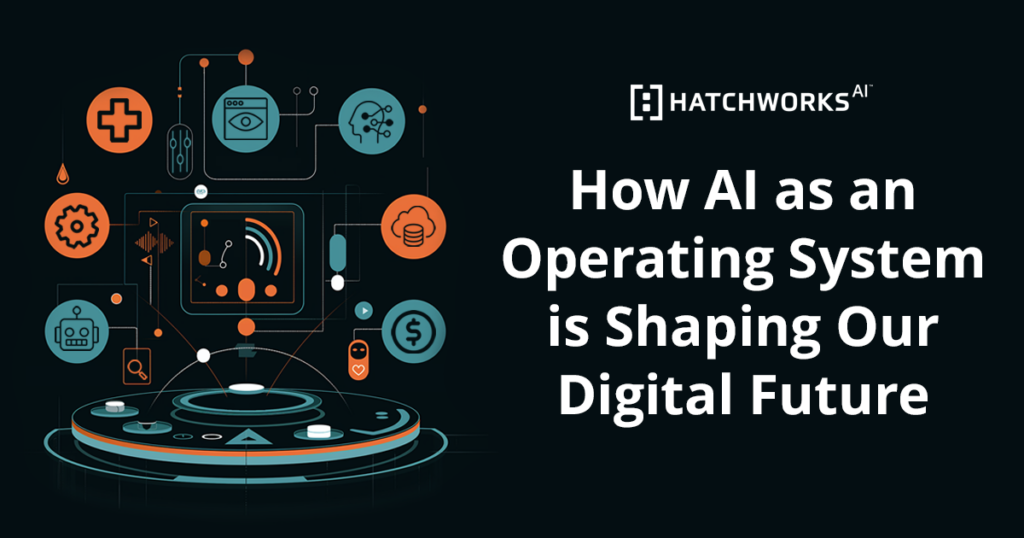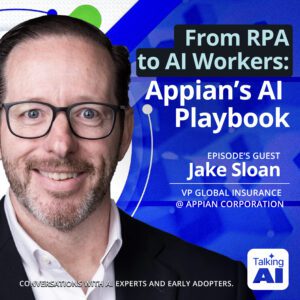When you were a kid and you thought of artificial intelligence (AI), you probably thought of human-like robots assisting actual humans with household tasks.
But the reality of AI today is far more pervasive and integrated into our environments—not as visible robots, but as an invisible network in our devices.

We’re closer than ever to seeing AI as an operating system, a step beyond AI integration that helps us run our daily lives and our work more efficiently by connecting those devices and communicating between them without our interference. It will change how we interact with our tech and how our tech interacts with each other.
What exactly does that look like?
In this article, I explain what an AI OS is and introduce the ways it’s shaping our digital future.
Understanding AI Operating Systems
Before I explain how artificial intelligence as an operating system is shaping future technologies, you need to know what an AI OS is and how it’s different from the operating systems you know and use today.
What is an AI Operating System?
AI operating systems integrate AI hardware and AI capabilities at their core so they can learn, adapt, and improve over time based on user interactions and data inputs.
The aim is to provide a more intuitive, personalized, and efficient computing experience by using advanced AI algorithms, large language models, and machine learning techniques.
Imagine if all of your devices were linked together by an AI operating system. That OS would collect data from each device, learn from it, and actively improve your day to day experience.
Here are some examples of data types it might use and what it could do with that data:
- Sleep Data (from devices like the Oura Ring): This would include details about sleep duration, quality, and patterns.
- Calendar Data (from services like Google Calendar): Information about scheduled appointments, daily routines, and important events.
- Health and Fitness Data (from wearables and health apps): Steps, heart rate, exercise sessions, and dietary habits.
- Communication Data (from emails, social media, and messaging apps): Patterns in communication frequency, the sentiment of messages, and networking habits.
- Environmental Data (from smart home devices): Preferences for lighting, temperature, and even the usage times of various appliances.
Before you get too excited, this exact AI OS doesn’t exist just yet.
At the moment, we have AI-powered operating systems only which integrate some AI functions but aren’t as autonomous.
There’s not an operating system for everything to plug into … things need to be built for a world of AI in order for that AI to work and scale,”
Adrian Aoun, CEO at Forward
How does AI OS differ from traditional operating systems and AI-powered operating systems?
The difference between traditional, AI-powered, and AI as OS is how present AI is or isn’t in its core functionality.
Your traditional operating systems, such as Windows, macOS, or Linux, provide a basic framework for managing hardware and running applications. They rely on pre-defined rules and algorithms to perform tasks.
For example, when you save a file on your computer to your desktop. A traditional OS does not use AI to complete or improve these tasks.
With AI-powered OSs, like iOS or Android, AI features and AI hardware are incorporated into a traditional OS framework. Examples of those features are an AI assistant like Siri or facial recognition.
Now, if we look at an AI operating system, the AI is at the core of the system. It can continuously learn and adapt based on user behavior and preferences, optimizing performance and providing intelligent recommendations and automation.
Here’s a table that breaks down their core differences:
| Traditional OS | AI-powered OS | AI OS | |
|---|---|---|---|
|
Core function
|
Manages hardware and software resources.
|
Adds AI features to manage specific tasks more efficiently.
|
AI manages all aspects of the system.
|
|
Decision making
|
Based on predefined algorithms without learning capability.
|
Uses AI to make smarter decisions in specific areas (e.g., security).
|
Fully autonomous decision-making across the system courtesy of AI.
|
|
User interaction
|
Standard user interfaces (GUI, command line).
|
Enhanced interfaces with AI elements (voice assistants, predictive interfaces).
|
Highly adaptive interfaces, possibly personalized by AI learning.
|
|
Learning capability
|
None.
|
Limited to specific AI-enabled features (learning user preferences).
|
Full learning capability; can adapt and evolve based on interactions.
|
|
Task management
|
Manual settings and user inputs.
|
AI assists in automating and optimizing tasks (e.g., scheduling).
|
Fully managed by AI, potentially with self-optimizing processes.
|
|
Personalization
|
Limited to user-configured settings.
|
AI-driven personalization based on behavior and data analysis.
|
Deep personalization, potentially adjusting the OS itself to user needs.
|
|
Examples
|
Linux, Windows (traditional versions), macOS.
|
Windows 10/11 with Cortana, Android with Google Assistant, iOS with Siri.
|
Theoretical only.
|
Key Components of an AI Operating System: What Will Make Them Work
When AI operating systems emerge onto the tech landscape there will be several key components making it possible for them to operate autonomously, learn from interactions, and adapt to the needs of its users.
They are:
- Machine Learning and Deep Learning Models
- A Data Management System
- Natural Language Processing (NLP)
- Neural Networks
- Autonomous Decision-Making Algorithms
- User Interface (UI) and Experience (UX) Design
- Security Features and Frameworks
- Integration Capabilities
Let’s look at each one briefly to understand its purpose, functionality, and the environment (or enablers) they need to work.
Machine Learning and Deep Learning Models
| Purpose | Functionality | Enablers |
|---|---|---|
|
These models allow the OS to learn from data, recognize patterns, and make decisions.
|
They are used for tasks like predictive typing, voice recognition, user behavior prediction, and personalized settings adjustments.
|
Access to large datasets, powerful processing capabilities to train models, and ongoing updates to models based on new training data.
|
A Brief Aside: LLMs as the Operating System 🤔
Some AI experts even believe that LLMs (large language models) will be the center of a future AI operating system, turning it instead into an LLM operating system.
Andrej Karpathy is one such expert. He suggests future LLMs will not only have enhanced capabilities but will be able to self-improve and communicate with other LLM systems.
He’s shown in the image below what that could look like:

A Data Management System
| Purpose | Functionality | Enablers |
|---|---|---|
|
To efficiently collect, store, and process the vast amounts of data the OS uses to learn and make decisions.
|
Includes the handling of data from internal system metrics, user interactions, and connected devices.
|
Advanced database systems, real-time data processing capabilities, and robust data privacy and security measures.
|
Natural Language Processing (NLP)
| Purpose | Functionality | Enablers |
|---|---|---|
|
Allows the OS to understand and generate human language, enabling it to communicate with users effectively.
|
Used in voice assistants, chatbots, and other communication interfaces.
|
Sophisticated NLP algorithms, training on diverse language data, and integration with speech recognition technologies.
|
Neural Networks
| Purpose | Functionality | Enablers |
|---|---|---|
|
To provide the framework for creating AI that can perform complex tasks, such as image recognition, speech recognition, or autonomous decision-making.
|
Mimics the human brain's interconnected neuron structure to process information.
|
High-performance computing (HPC) systems, specialized hardware like GPUs or TPUs, and advanced neural network architectures.
|
Autonomous Decision-Making Algorithms
| Purpose | Functionality | Enablers |
|---|---|---|
|
To enable the OS to operate independently without human intervention.
|
Used for managing system resources, security, software updates, and troubleshooting.
|
Robust algorithmic frameworks, extensive testing and validation to ensure reliability and safety, and ethical AI guidelines.
|
User Interface (UI) and Experience (UX) Design
| Purpose | Functionality | Enablers |
|---|---|---|
|
To ensure that the OS is usable and accessible to humans, adapting to individual needs and preferences.
|
Includes adaptive interfaces that change based on the context of use and the specific needs of the user.
|
AI-driven analytics to understand user behavior, advanced UI frameworks, and feedback loops from user interactions.
|
Security Frameworks
| Purpose | Functionality | Enablers |
|---|---|---|
|
To protect the OS and its data from unauthorized access and cyber threats.
|
AI-driven security systems that predict, detect, and respond to threats in real-time.
|
Integration of AI with traditional systems, security protocols, continuous monitoring systems, and real-time threat intelligence.
|
Integration Capabilities
| Purpose | Functionality | Enablers |
|---|---|---|
|
To allow the OS to work seamlessly with a wide range of devices and applications, from IoT devices to enterprise software systems.
|
Includes APIs and middleware that allow for easy and seamless integration with other systems and technologies.
|
Standardized communication protocols, robust API management, and flexible software architecture.
|
The Role of AI OS in Connectivity and the Internet of Things (IoT)
When tech works in isolation, we, as its users, are heavily involved in its operation. If I’m cold for example, I can open up the app that connects to my thermostat and adjust it. I would be overriding its standard setting (usually to maintain a specific temperature) to suit my own comfort.
But what if that app automatically knew my body temperature, analyzed the current weather, and automatically adjusted my home’s thermostat for me?
Or what if your fridge was able to sense it had run out of milk and automatically added milk to the shopping list on your phone?
That’s a world where an AI operating system enhances the connectivity of your tech, creating an efficient and responsive IoT.
While we’re not quite at this reality, AI-powered operating systems are getting us closer.
For example, smart home platforms like Google’s Nest and Amazon’s Alexa are already leveraging AI to learn user preferences and automate tasks. These systems can adjust lighting, temperature, and other settings based on user behavior and external factors
In the industrial sector, AI-powered operating systems are being used to monitor and optimize complex manufacturing processes. They’re able to predict maintenance needs, optimize manufacturing processes, and enhance safety protocols.
It’s this connectivity of devices, items we’re already so reliant on, that puts so much power in an AI OS to change how we use and interact with tech in the future.
AI OS: The Final Frontier for User Experience
Personalization in user experience is more than desired, it’s expected. In fact, McKinsey reports a staggering 71% of consumers expect personalization from the brands they use.
But personalization at scale is only possible with AI and thanks to the potential capabilities of an AI OS, we’re on the cusp of hyper-personalized user experiences across industries and technologies.
That’s because AI as an operating system brings unprecedented predictive functionalities into everyday technology use.
These systems will be able to learn from individual user interactions, and then tailor interfaces and functionalities to personal habits and preferences.
For example, an AI OS can anticipate a user’s needs, predicting the right apps to suggest at different times of the day or adjusting settings based on the environment for optimal comfort.
Imagine waking up and a specific meditation being chosen and played for you because your AI OS knows you have a big presentation later that day. It would know your needs before you knew them yourself.
What’s more is that AI operating systems can significantly enhance accessibility, making technology easier and more intuitive for everyone, including those with disabilities.
By understanding voice commands, gestures, and even predicting the needs of users based on their usual behavior, AI OSs enable a smoother, more responsive interaction
It’s a user experience only written about in science fiction novels and yet it’s closer than ever to becoming our reality.
Challenges and Considerations in Developing AI Operating Systems
While AI operating systems hold immense potential, their development and implementation come with a unique set of challenges for careful consideration.
Being aware of them can help us plan solutions and mitigate risk as we get closer to our AI OS future.
Here are a few of the most important ones:
Technical Limitations:
One of the primary technical hurdles is the sheer complexity of creating an AI system capable of seamlessly integrating with and managing a wide range of hardware and software components.
If an AI OS builder is to ensure compatibility, performance, and stability across diverse devices and platforms, it’s going to take extensive research, testing, and optimization.
And then there’s security.
Security Concerns:
As AI OSs have deeper access to personal and sensitive data to perform their functions, they also become attractive targets for cyber attacks.
There’s the risk of AI being manipulated or corrupted by external threats. Securing these systems against vulnerabilities that could be exploited by attackers requires robust, constantly updated security protocols.
Ethical Implications:
The decision-making by AI can also raise ethical concerns, particularly around privacy and autonomy. As AI OSs predict and act on user preferences, they must navigate the fine line between helpful personalization and invasive surveillance.
There’s also the issue that decisions made by AI could be biased. This is because the data they are trained on could be flawed or biased, potentially leading to unfair or discriminatory outcomes if not carefully monitored and corrected.
Embracing AI-Driven Operating Systems for a Smarter Future: Where Do We Go From Here?
AI operating systems are poised to revolutionize the way we interact with technology, ushering in a new era of personalized, efficient, and intuitive computing experiences.
As businesses and developers recognize the potential of AI OS, we can expect to see a surge in investment, research, and development efforts aimed at pushing the boundaries of what’s possible with this transformative technology.
How you proceed into this future is up to you.
You can:
- Try to build an AI OS and introduce this futuristic technology to the masses
- Stay on the forefront of developing technologies by using AI-powered OSs, preparing yourself to adopt an AI OS as soon as it is commercially available
- Or risk falling behind in life and in business by sticking with old models of tech for too long.
At HatchWorks we know where our interests and intentions lie.
If you want to make the most of emerging AI and keep your business ahead of the competition you can do so with our library of resources:
- Our Built Right podcast where we interview AI experts.
- Our newsletter where we share insights, news, and upcoming events and training.
- Our article: Leveraging Generative AI in the Workplace: A Guide for CXOs.
You can also learn how we use AI to build better, faster, smarter software for our clients here.
Transform Workflows into 24/7 AI Engines
Let Agentic AI Automation take the wheel—boosting speed, accuracy, and ROI at scale.



